Note: for the full suite of measurements from the SoundStage! Audio-Electronics Lab, click this link.
 Perched atop my ladder outside on a gorgeous fall Saturday, working through our home-improvement list—my favorite COVID-lockdown activity—I was excited to receive this message from the SoundStage! Network’s founder, Doug Schneider: “Your first review product is in—the new NAD C 298 power amp.”
Perched atop my ladder outside on a gorgeous fall Saturday, working through our home-improvement list—my favorite COVID-lockdown activity—I was excited to receive this message from the SoundStage! Network’s founder, Doug Schneider: “Your first review product is in—the new NAD C 298 power amp.”
Down the ladder . . . sip of coffee, phone in hand, tap tap tap into my keyboard this URL: nadelectronics.com. Scroll . . .
“Excellent!” I thought. “It is the one with that class-D Eigentakt amp technology from Purifi Audio I keep hearing about.”
I’d already read everything SoundStage! had published about this promising new company, from Doug’s 2019 meeting overseas with Purifi cofounder Peter Lyngdorf, on SoundStage! Global, to his listening impressions of Purifi’s engineering-demo version of the Eigentakt published last year on this site, to the SoundStage! Take 2 video with Jay Lee about that same demo amp. Needless to say, I was intrigued about NAD’s implementation of the Eigentakt in their C 298.
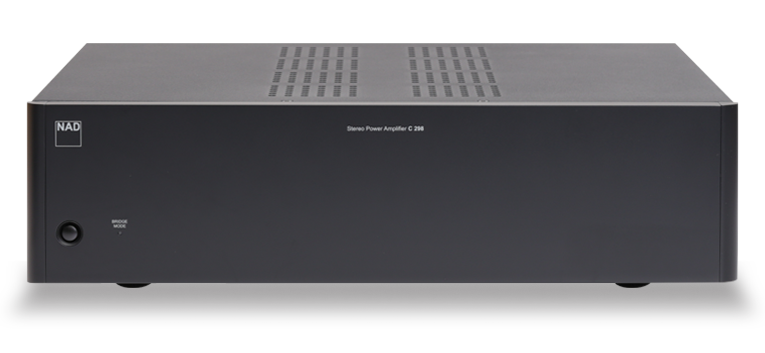
After finishing that day’s honey-do list, I enjoyed digging into NAD’s informative website to learn more about this $1999 (all prices USD) two-channel power amplifier. But my interest wasn’t limited to Purifi and their new amp tech—my fondness for NAD’s approach to audio gear goes back 20 years. I was first exposed to them through a part-time job with a local audio retailer that I held while still in school, when I first realized that high-fidelity sound was within reach in the form of the uniformly gray models from NAD. That was the era of NAD’s impressive C 372 integrated amplifier, which packed a powerful wallop and had a fuller, more enjoyable sound than anything else in its price range at the time. Even their smaller receivers and amps sounded better to me than most products of similar price then available.
So I couldn’t help but wonder if the new C 298, filled with a highly anticipated new technology, would still have that “NAD sound” I’d grown to love in the 20 years since my first encounter—from their C 325BEE and C 355BEE integrateds (the latter still in use with original PSB Alpha speakers, a “warm hug” of a sound signature) to their CD players, the C 541i having early on been a staple of my main hi-fi system before being replaced by the Masters M55 SACD/CD player. Could the ultramodern C 298 provoke the same nostalgia?
Description
The C 298 is the second commercial audio product from NAD to feature Purifi’s class-D amplifier technology, following the Masters M33 integrated amplifier-DAC, reviewed by Roger Kanno on this site last September. Just released is the seven-channel Masters M28 power amplifier ($4999), which Roger is also reviewing. For each of these, NAD manufactures the Eigentakt amp modules themselves, under license from Purifi Audio. Nor does the C 298 use the same Hypex-made switching power supply found in Purifi’s Eigentakt, or the same input circuitry. Instead, the C 298’s switching power supply is of NAD design and manufacture, which allowed them to include additional features. But that’s all I’ll say about the Eigentakt technology, as Doug has written plenty about it. I’ll add only that it’s made quite a stir among audiophiles for its combination of fairly high power with standard-setting low levels of distortion and noise.
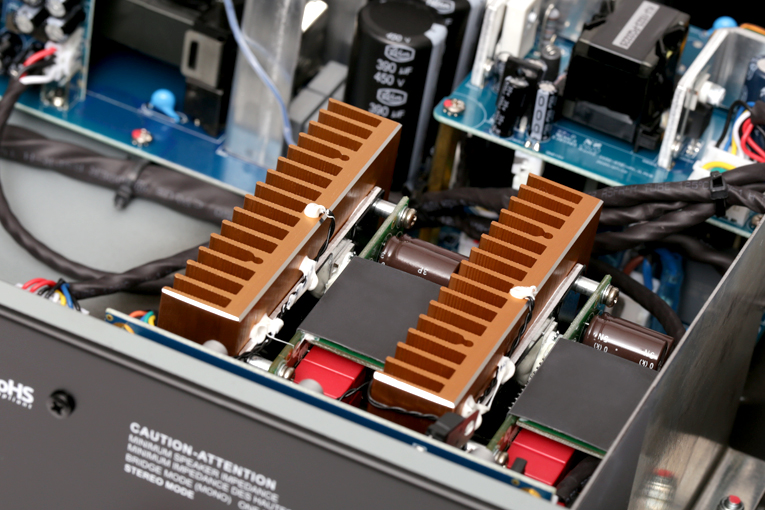
The C 298 is deliberately plain, with perfectly acceptable build, but of appropriate quality and usability. It measures 17.1″W x 4.75″H x 15.4″D and weighs 24.7 pounds. The front panel, which feels like a plastic-based composite, is a swath of flat, smooth gray devoid of character lines, or any style accents at all. Like the rest of the case, which is made of metal, the faceplate is plain Jane, its smooth expanse broken only by an unlabeled on/off button and a Bridge Mode status LED in the lower left corner—more about these later.
The rear-panel hardware is also of suitable quality for the price, with easy-to-decipher labels for all switches, inputs, and outputs. NAD has also packed some nice features into the C 298: It can turn itself on from standby mode when it detects a signal of one of three user-selectable levels: High, Mid, and Low (I found no auto-off function). It also has a pair of single-ended Line Out jacks (RCA) for daisy-chaining it to another amplifier.
The rear-panel connections include balanced (XLR) and single-ended (RCA) inputs for each channel, 12V in/out triggers, and a Bridge slider that allows the NAD to become a mono amplifier that can output >620W into 8 ohms (at 1kHz, 0.1% THD). In stereo mode, which I used for all of my listening, the maximum power output is specified as 185Wpc into 8 ohms or 340Wpc into 4 ohms, both channels driven, 20Hz–20kHz at the rated THD. The claimed THD, 20Hz-20kHz, is <0.005% (1–185W, 8 or 4 ohms). If these specs are accurate, that’s a substantial amount of clean power. Interestingly, the C 298 has a very high damping factor of >800 (ref. 8 ohms, 20Hz–6.5kHz), indicating that it should maintain good grip on the speakers’ drivers.
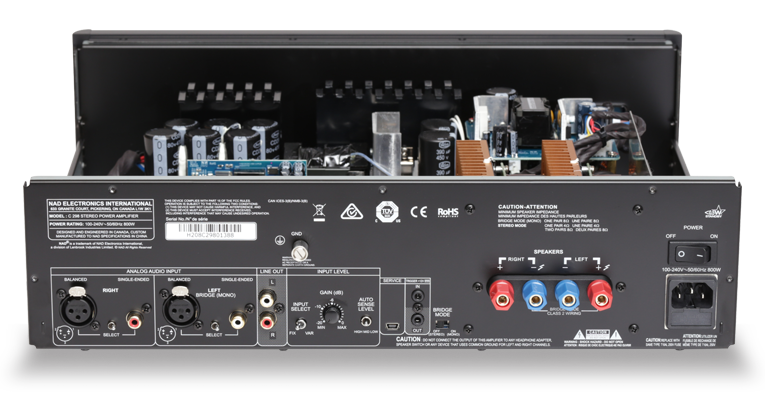
Also on the rear panel is a toggle switch, its two positions labeled Fix and Var, for fixed- or variable-gain operation. I used the C 298 with its fixed gain of 28.6dB, though I did try varying the gain with the Gain dial next to the toggle, to make sure it worked. The overall gain can be set anywhere from 28.5dB down to 8.5dB. The Eigentakt amplifiers themselves provide 13dB of gain, so it appears the variable gain circuitry simply acts as an input attenuator. The supplied power cord is of nice quality and feels more substantial than I expected for the stock cord of a $1999 amp.
System and startup
My basement listening room measures 18′ 8″L x 11′W x 7′ 6″H and has a carpeted concrete floor. To dial in its acoustic I’ve placed Vicoustic Multifuser DC2 diffuser panels on the wall behind the speakers, as well as at the first-reflection points on the sidewalls. The wall behind my listening position is treated with absorption panels measuring 8′W x 2′H x 4″D.
The equipment on my rack has evolved over many years, and currently includes a Torus RM15+ power isolation transformer, which has ten outlets on the rear, into which are plugged all components—including hungry power amps—with either Signal Cable MagicPower or Pangea Audio AC14SE power cords. The Torus itself is fed power from a dedicated circuit on our home’s electrical panel via 10-gauge stranded-copper wires and a PS Audio Power Port receptacle.
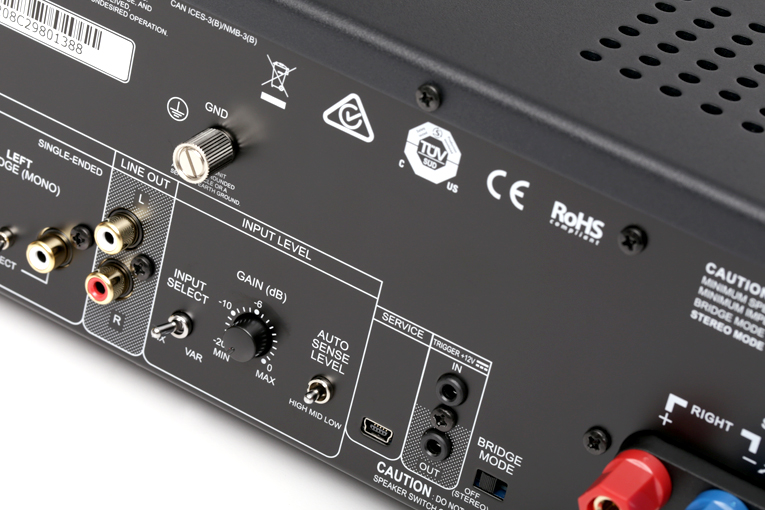
Music is streamed from a MacBook Air laptop computer over my home network to a Bryston BDP-1 streamer using Roon software. From there, a Signal Cable AES/EBU digital link feeds a Bryston BDA-1 DAC, which in turn feeds a Bryston BP25/MPS-1 preamplifier and a Bryston 3B SST2 stereo power amplifier ($3595, discontinued), specified to output 150Wpc into 8 ohms or 250Wpc into 4 ohms. Providing nearly full-range sound is a pair of 5ʹ-tall, 102-pound, three-way Dynaudio Contour S5.4 speakers set about 8′ apart and 10′ from my listening position. I’ve recently replaced their floor spikes with IsoAcoustics Gaia II isolation footers.
After rearranging the electronics to accommodate the NAD C 298, I ran Signal Cable Analog Two balanced interconnects from the Bryston BP25 preamp to the NAD, and connected my speakers to the C 298 with Signal Cable Classic 10-gauge speaker cables.
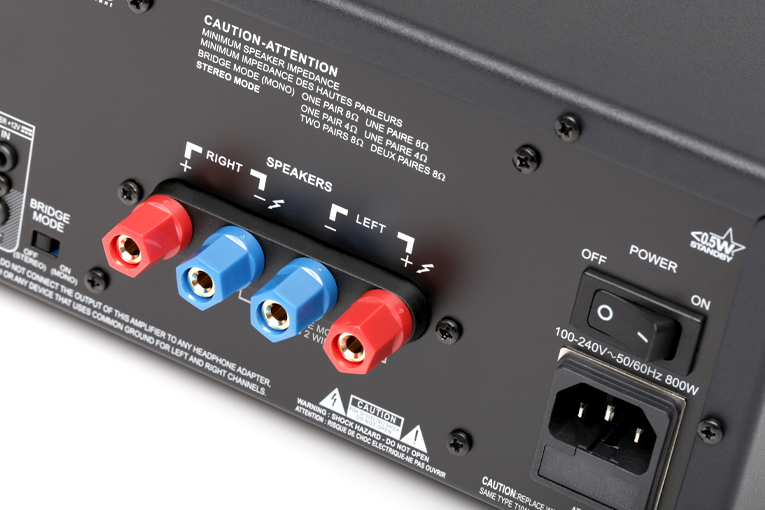
I made sure the C 298’s master Power rocker was switched on, which puts it in Standby mode. For daily use, the unlabeled button in the bottom left of the front panel is used to power up the amp from Standby. Above this button is an LED that glows amber in Standby; when pressed, the LED briefly glows red as the amp warms, then blue when the C 298 is fully powered up. Next to this button is the Bridge Mode LED, which illuminates when the amp has been bridged and is now operating as a monoblock.
The C 298—not my speakers—emitted a soft click when it transitioned from warm-up to fully On. Setup and first power-up were uneventful, and throughout my time with it the C 298 sprang no unpleasant operational surprises. The listening sessions for my first review for SoundStage! Hi-Fi had officially begun.
Sound
But feeling that a couple days of running in the NAD C 298 wouldn’t hurt, I didn’t begin my first session of critical listening until later in the week. I played some old standbys I’m very familiar with, beginning with Daft Punk’s Random Access Memories (16-bit/44.1kHz, Columbia/Tidal), one of my favorite albums, and one whose sound has a lot going for it. “Giorgio by Moroder” begins with the voice of Giorgio Moroder as he tells a brief story about his early days experimenting with synthesizers, while a super-funky bass line courtesy Nile Rodgers anchors the music. Then Daft Punk’s own synths enter, and the track builds and builds to a frantic climax that has challenged the abilities of many a hi-fi.
Everything else in this track is built on and around those bass and synth lines, and following them during this long crescendo was surprisingly easy through the C 298. I was surprised because my reference amplifier, the Bryston 3B SST2, is known for bass grip, speed, and extension—for the NAD to impress me just as much is, well, impressive, given that the Bryston costs almost twice as much.
I let the rest of the album play out, enjoying all the layers of detail presented to me by the C 298 with such apparent ease. In each track, voices and synths are added over electric bass and those drums, layer upon layer. Random Access Memories highlighted some of the NAD’s strengths—the C 298 delivered huge amounts of detail across the entire audioband. The album’s high energy came through in spades, the amp always providing quick-sounding bass, mids, and highs. Its reproduction of the treble was excellent—I heard no faults whatsoever. I soon began to prefer its ever-so-slightly more “polite” sound over the slightly splashier highs I’m used to from my Bryston, whose sound can, at higher volume levels, be a little too hot for my taste.

The drums in every track of Random Access Memories are energetic and snappy in all the right ways, and the C 298 did them justice from start to finish, always providing plenty of inner detail of each bass, snare, and cymbal strike while relaying great energy, never by making the drums predominate over anything else in these mixes.
In several more sessions of casual and critical listening I played music at higher volume levels than I usually do, to hear if NAD’s output specs were accurate. I found that the C 298 was very comfortable delivering all its power—even when I drove it hardest, the grilles of its top-panel vents were only slightly warm to the touch. My ears always gave way before the C 298 reached its power limits—it could easily drive my 4-ohm Dynaudio Contour S5.4s into room overload without strain or compression. Of course, that’s not actually enjoyable—too loud is too loud—but it’s nice to know that the C 298 had power to spare, at least in my room. And with class-D amps commonly used in powered subwoofers designed to deliver only bass, the power and grip the C 298 exerted on my speakers’ bottom end was no surprise. But I wanted to learn about more than just the C 298’s prowess down low . . .
JS Ondara’s singing in “Lebanon,” from his Tales of America (24/48 FLAC unfolded to 24/96 MQA, Verve/Tidal), gave the C 298 a shot at reproducing a track with big vocal swings that can sound a bit harsh when played at or near a realistic “live” volume level—in this case, 85-90dB, C-weighted, at my listening position. Countering the common assumption—I read it on Internet forums all the time—that class-D amps sound thin and/or harsh, the C 298’s sound was thoroughly relaxed, each aural image presented with tons of minute details.
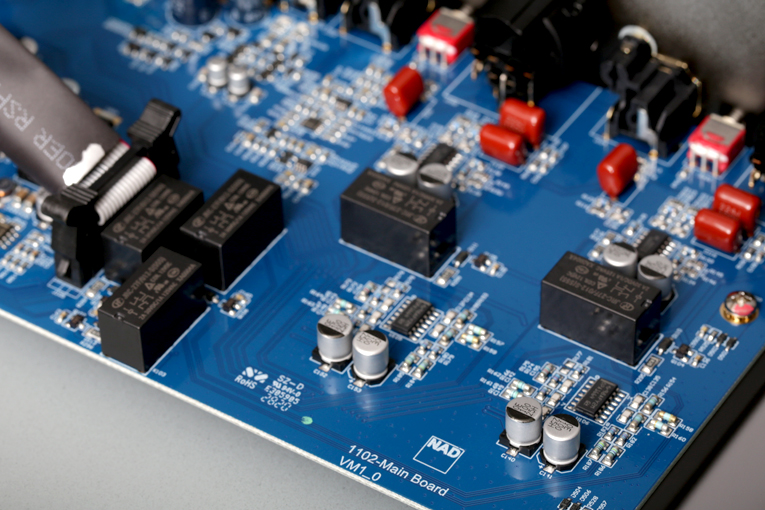
The C 298’s super-clear reproduction of Ondara’s voice let me very easily hear when he slightly clipped his vocal microphone—something I hadn’t noticed before. But the NAD didn’t sound harsh when that mike clipped—it let me hear what was there without adding objectionable artifacts of its own. In fact, the NAD exceeded my Bryston’s performance in this regard by providing, in the most challenging parts of this track, at least as much detail but with less harshness. Images were locked firmly in place, with surprising amounts of space between them—surprising because such levels of detail and definition of images were, again, better than I’m used to hearing with the more expensive Bryston.
Another challenging track is “Lost Without You,” from Freya Ridings’s eponymous first album (24/44.1 FLAC unfolded to 24/88.2 MQA, Good Soldier/Tidal): a delicate female voice accompanied at first by piano, and soon by huge synthesized bass and increasingly intense singing from Ridings. As the intensity grows, I suspect many systems would begin to make her voice sound overly sibilant, which in this recording it somewhat is. But the C 298 walked a fine line, giving the impression it was reproducing the sibilance actually recorded without adding any sharpness of its own to her voice.
This track best summed up for me what the NAD did really well, and what it didn’t do quite as well as my reference amp: It presented details of the voice and piano with great ease, and its sound was relaxed without being at all lazy or slow. The reproduction of music seemed to just naturally and effortlessly happen—like a sportscar cruising at only seven-tenths of its capabilities.

And when, about 1:25 into “Lost Without You,” the heavy bass enters, I felt the C 298 indeed lacked a bit of bass weight compared to my Bryston 3B SST2. Still, the quality of the C 298’s bass, and its pace and timing, were impressively rock-solid and fast. It was the quantity of bass that was just slightly less than I’m used to, nor did it achieve as much room lock as does my Bryston, which also seems to give the sound more weight. But this was the only parameter of sound reproduction in which the NAD didn’t match up to the Bryston.
Comparison: Purifi Audio Eigentakt
A few weeks into my listening for this review, I got an exciting message from Doug Schneider: “People will obviously want to know where the NAD sits relative to Purifi’s demo amp.” Well, twist my arm, Doug. Shortly thereafter, he dropped off the Eigentakt at my house.
As described in Doug’s articles about it, Purifi’s Eigentakt is a demo version for engineers—it’s not a commercial product available for purchase by consumers. But because it embodies how the Purifi engineers feel their technology should be implemented, it makes a great point of reference in terms of sound quality.
The Eigentakt comes in an aluminum case with a red top and measures just 10″W x 2.5″H x 12.5″D. But while a lot smaller than the standard-size NAD C 298, it’s specified to output more power: 200Wpc into 8 ohms or 400Wpc into 4 ohms. On the rear panel are some basic hardware and minimal connection options. I used its balanced (XLR) inputs, as I did with the NAD, and the banana plugs of my speaker cables fit the banana jacks on the Purifi. (It also has Neutrik speakON connectors, which the Purifi engineers prefer.)
I hooked it up, turned it on, and began listening right away—Doug had already put lots of listening hours on the Purifi in his own system, so I didn’t have to worry about burn-in. In no time at all, I could tell that the Eigentakt’s sound was similar to the C 298’s, but with even more of the best elements of that sound. Over the next few evenings, with lots of switching back and forth, it became apparent that the Eigentakt is a great amp—it seemed to reproduce all the tonal detail, drive, spaciousness, and power most listeners could want, without sounding forceful or hard. As it did from the NAD, music flowed very easily from the Eigentakt at all volumes, from whisper-quiet to extraordinarily loud—in fact, it flowed with even more ease from the Purifi.
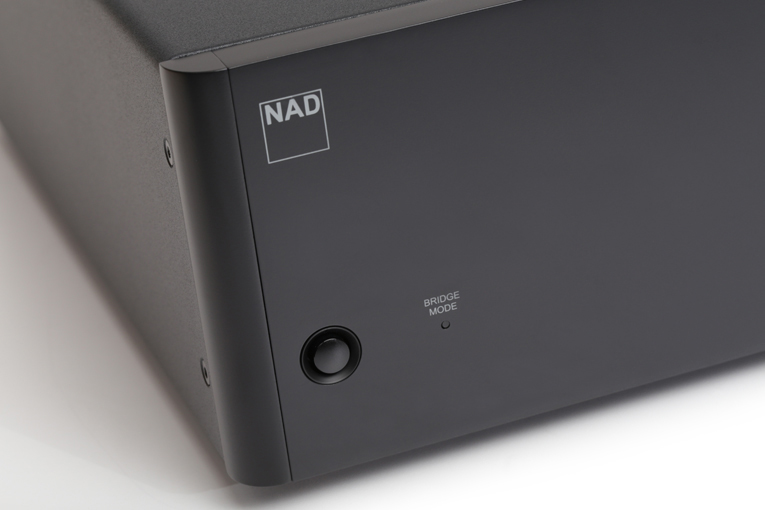
The Eigentakt also improved on the NAD’s bass extension and detail, more closely aligning with the Bryston’s capabilities in these regards; the bass was also more substantial when that was called for. But that bass was still tight and tuneful, like the NAD’s. I found the Eigentakt, also like the C 298, to sound very clean throughout the audioband without being overly analytical.
In short, the Eigentakt does everything the NAD did, and a couple of things even better. It presented more space around aural images, and offered slightly more textural and tonal detail. For instance, while the two amps’ positioning of images, and overall size, depth, and width of soundstage, were comparable, the Eigentakt somehow delineated each image a bit more decisively. I heard this with “These Bones,” from the Fairfield Four’s I Couldn’t Hear Nobody Pray (16/44.1 FLAC, Warner Bros./Tidal). Their great a cappella singing came across as five individual sound sources firmly anchored with spaces between them, rather than a left-to-right wall of voices with less “air.” The Eigentakt also more closely approached a fully realistic vocal weight and physical presence for each singer, which is why I mentioned the textural and tonal details. But those differences of texture, detail, and reproduced spaces on the soundstage were exceedingly small.
All told, the sounds of these two amplifiers are cut from the same cloth—as you’d expect, given their shared amplifier technologies.
Conclusion
With the C 298’s balanced and single-ended inputs, auto-on sensing, fixed and variable gain, enough power output for most applications, the ability to be used as a far more powerful monoblock, and the serviceable but nonextravagant build quality and visual design long typical of this company, NAD has done a wonderful job of implementing Purifi Audio’s Eigentakt amplifier technology into a commercial product that is, at least in features and looks, distinctly their own. The C 298 is also a conventional-looking amplifier that will visually fit nicely into any traditional audio system.
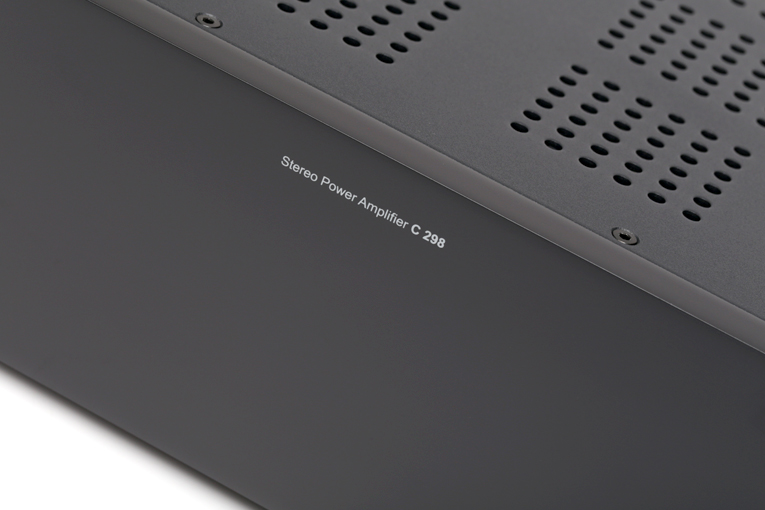
I think the C 298’s sound quality, too, would be welcome in any system, almost regardless of that system’s total price. In my own rig it provided clean, smooth sound that was never clinical or etched, and its speed, dynamics, and power output resulted in no shortcoming that I could hear—except in a few small areas when I pitted it against Purifi’s demo version of the Eigentakt. The C 298 was also easily powerful enough to drive my speakers to high volume levels—and not only did it compare with my Bryston 3B SST2 power amp, it equaled or bettered it in every way other than bass weight.
But before it was discontinued, the Bryston cost almost twice the C 298’s price. The value propositions NAD has been fine-tuning for decades are continued in the C 298. If you’re in the market for a new power amp, and that part of your budget goes even as high as $5000, it will be worth your while to give the C 298—at only $1999—a good listen. You might save yourself a bundle.
. . . Evan McCosham
evanm@soundstagenetwork.com
Note: for the full suite of measurements from the SoundStage! Audio-Electronics Lab, click this link.
Associated Equipment
- Speakers: Dynaudio Contour S5.4 with IsoAcoustics Gaia II isolation feet
- Preamplifier: Bryston BP25 with MPS-1 outboard power supply
- Power amplifier: Bryston 3B SST2
- Digital-to-analog converter: Bryston BDA-1
- Streamer and computer: Bryston BDP-1 streamer, Apple MacBook Air laptop computer running Audirvana, Roon
- Digital links: Signal Cable Silver Reference (AES/EBU coax)
- Analog interconnects: AudioQuest Red River balanced (XLR), Signal Cable balanced (XLR)
- Speaker cables: Signal Cable 10AWG with banana plugs
- Power cords: Pangea Audio AC-14SE, Signal Cable Magic
- Power conditioner: Torus RM15+ power isolation transformer
- Room treatments: Vicoustic Multifuser DC2 diffusers, custom absorption panels
NAD C 298 Stereo/Mono Amplifier
Price: $1999 USD.
Warranty: Two years parts and labor.
NAD Electronics International
633 Granite Court
Pickering, Ontario L1W 3K1
Canada
Phone: (905) 831-6555
Fax: (905) 837-6357
Website: www.nadelectronics.com






















